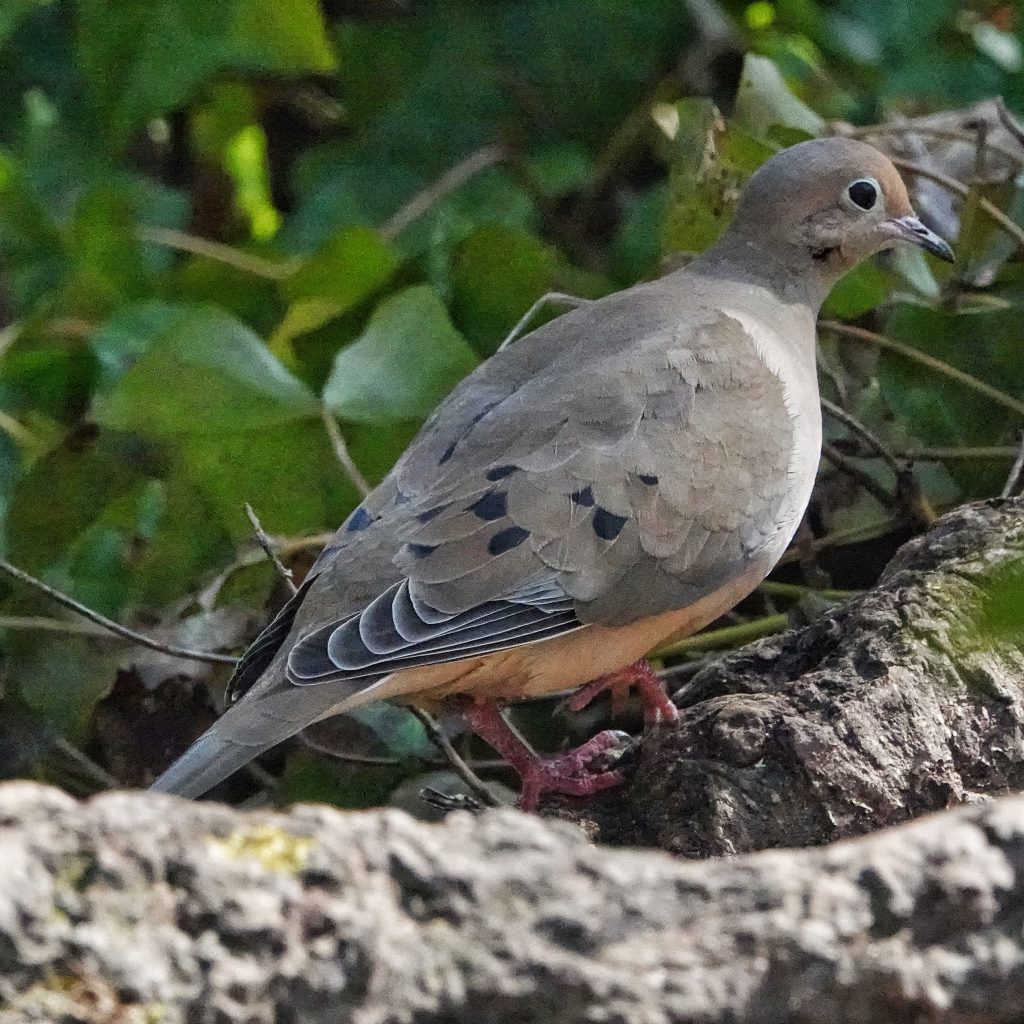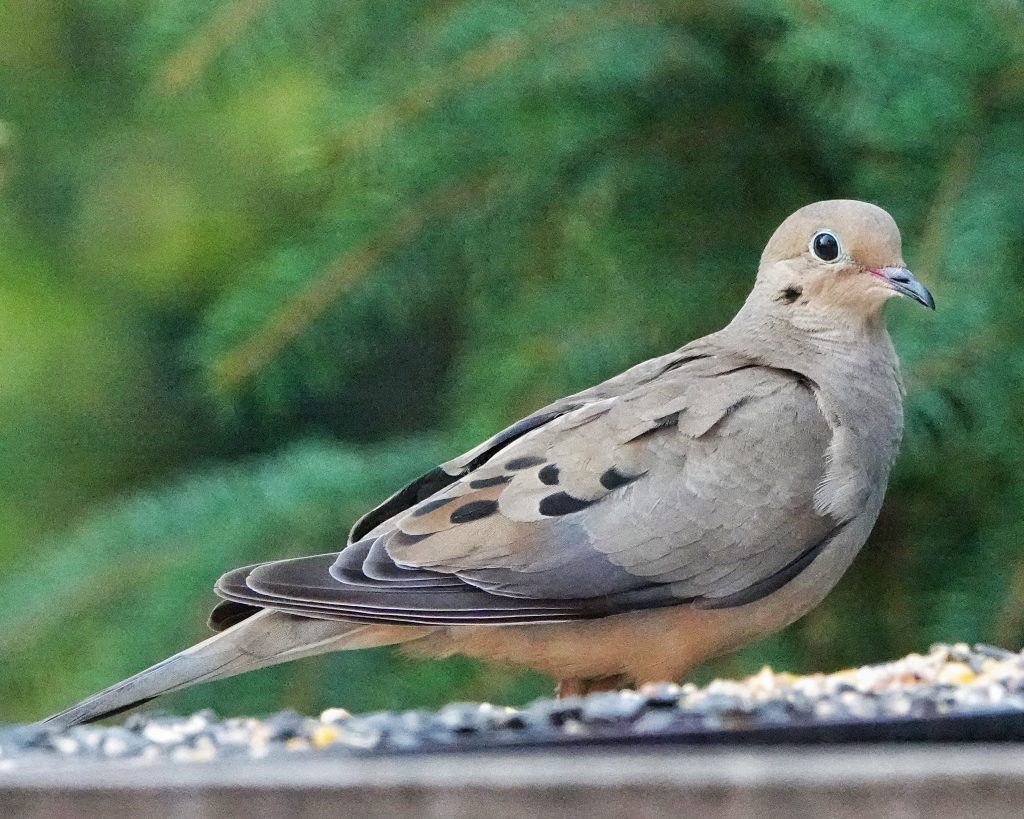
Who doesn’t love mourning doves, with their subtle beauty, melancholy call, distinctive silhouette, and seemingly gentle ways? I’ve wanted to profile these birds for quite some time, but had a hard time getting very many quality photos of them. That has not been a problem while House Sitting – 10,000 Things of the Pacific Northwest in Portland’s west hills, since there is a trio that are frequent visitors to N.’s platform feeders. They are photogenic and cooperative birds that sometimes allow me to approach within 20’, although most of these photos were taken through an open door from inside the blind of the house.
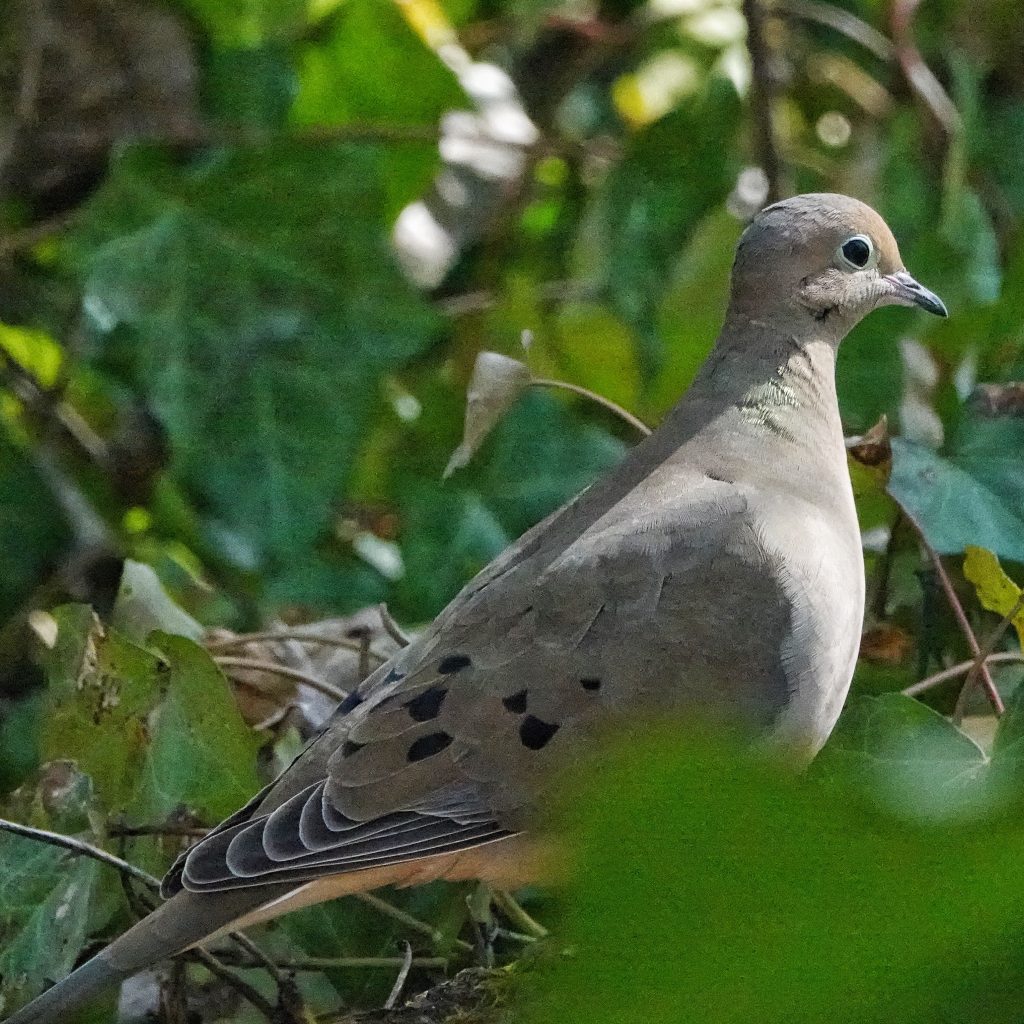
When I started doing a literature search on these birds I really expected to read that they were being threatened by the encroachment of Eurasian Collared Doves, since my experience in the dozen years since I first started seeing the collared doves is that they have replaced the Mourning Doves in many of the places that I used to regularly see Mourning Doves. But although Poling/Hayslette; 2010 noted the potential for problems for the Mourning Doves, Green, et al.;2020 found that “Mourning dove occupancy was stable or increasing across our study area, and despite overlap in resource use and co-occurrence between mourning doves and Eurasian collared-doves, we found no evidence that collared-doves are extirpating mourning doves from preferred habitat during the breeding season.” https://wildlife.onlinelibrary.wiley.com/doi/am-pdf/10.1002/jwmg.21835
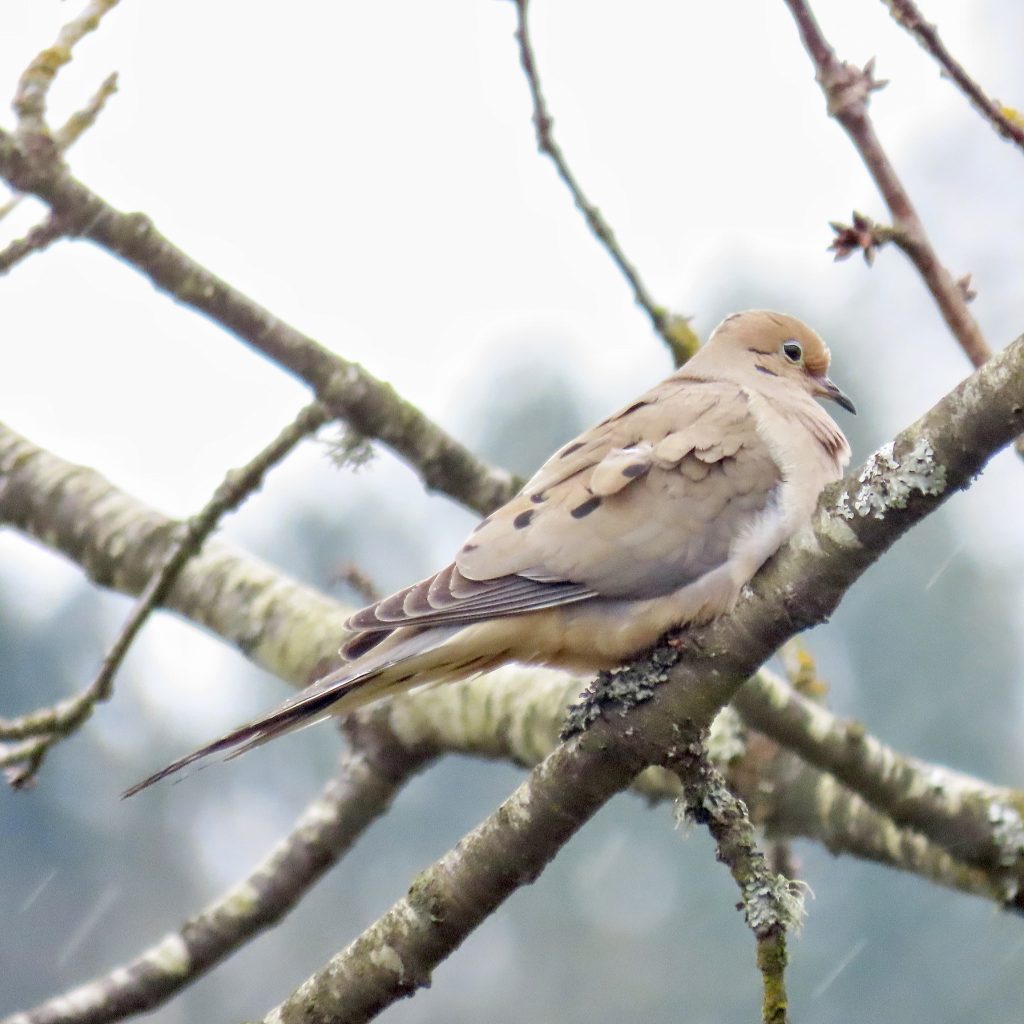
“The song (or “perch-coo”) is given mainly by unmated males from a conspicuous perch. It’s a soft coo-oo followed by two or three louder coos. You can often hear paired males give the three-parted “nest call” while nest-building: a coo-OO-oo, highest in the middle. Females sometimes call ohr ohr while sitting on the nest.” https://www.allaboutbirds.org/guide/Mourning_Dove/sounds. “The Mourning Dove’s soft call, which gives the bird its name, is a sad-sounding cooOOoo-woo-woo-woooo. Those unfamiliar with this plaintive, hooting vocalization often think they are hearing a Great Horned Owl or other owl species. An interesting non-vocal sound of the Mourning Dove is the loud “whistle” made by its wings as it takes off and lands. As with the American Woodcock and Wilson’s Snipe, air rushing through wing feathers produces these sounds. The dove’s take-off and landing whistles serve as an alarm signal, warning other birds of potential dangers nearby. These sounds are also associated with the dove’s courtship displays.” Mourning Dove – American Bird Conservancy
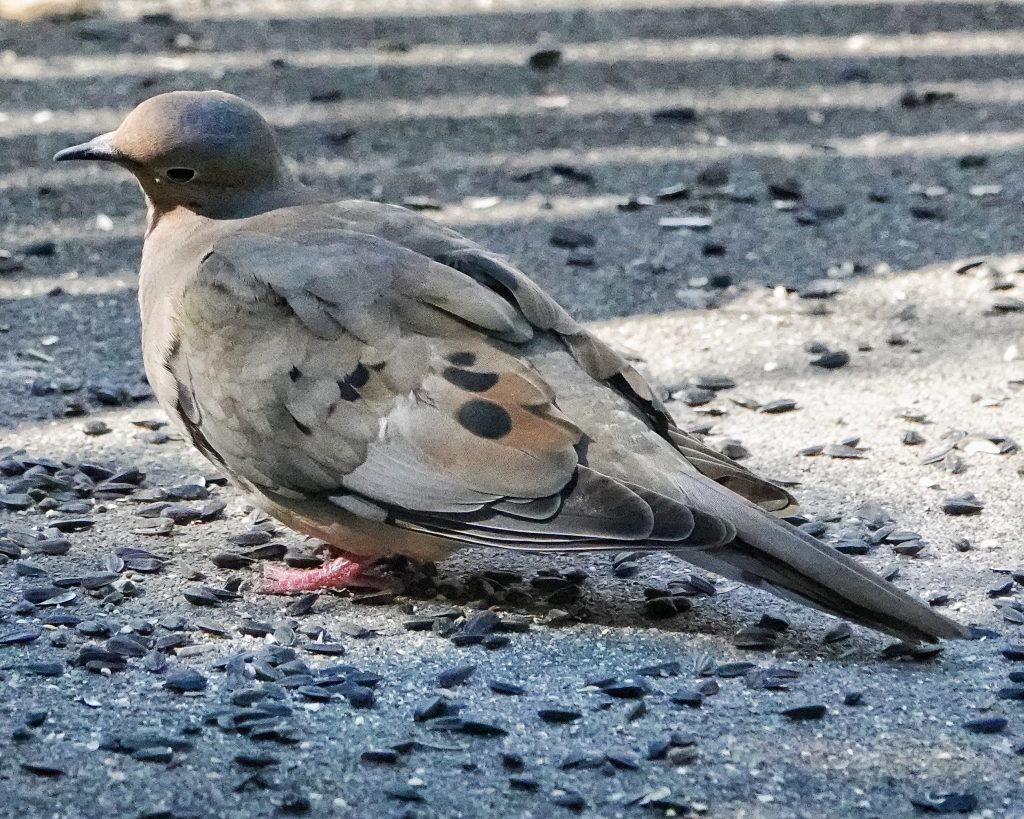
“Mourning Doves eat roughly 12 to 20 percent of their body weight per day, or 71 calories on average…Perhaps one reason why Mourning Doves survive in the desert: they can drink brackish spring water (up to almost half the salinity of sea water) without becoming dehydrated the way humans would.” Mourning Dove Overview, All About Birds, Cornell Lab of Ornithology; “The Mourning Dove, along with other pigeons and doves, is among the few birds that can drink using suction. Other birds must drink water by filling their bill with the liquid, then tilting their heads back, relying upon gravity to deliver water to swallow.” Mourning Dove – American Bird Conservancy
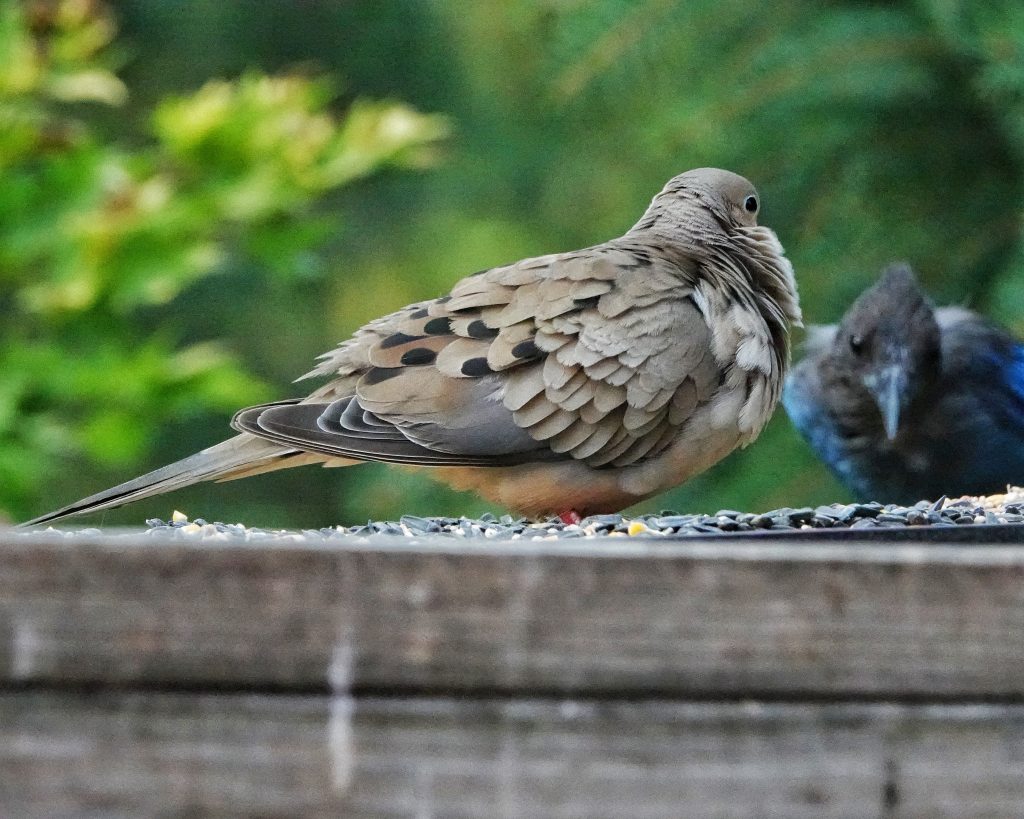
“When they sleep, their head rests between their shoulders, close to the body. They do not tuck their little heads under their shoulder feathers, like a lot of other birds do…Their long, pointed wings are almost falcon-like in appearance, while their pointed tails are longer than those of any other doves. These “design features” enable the birds to fly fast. Mourning doves have been clocked at 55 mph!” 13 Fascinating Mourning Dove Facts | Birds & Blooms
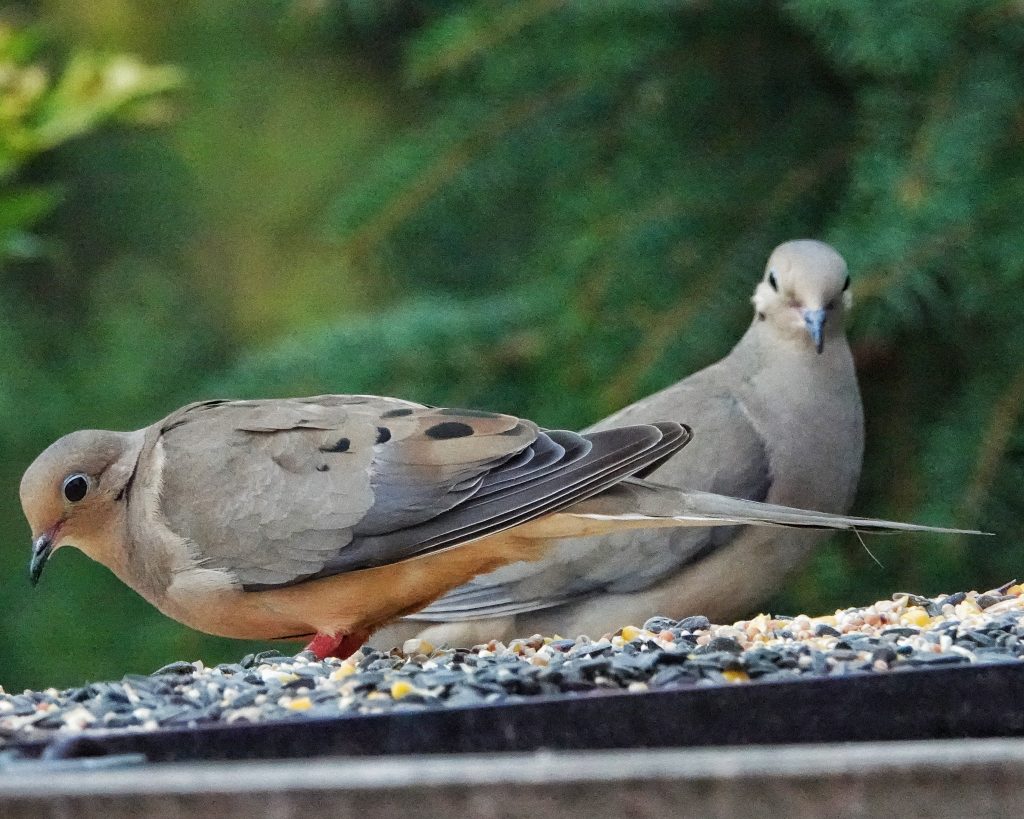
“Mourning doves are extremely prolific breeders and can raise up to 6 broods in one year, although the average is 3. It’s essential that mourning doves are able to reproduce so quickly as quite a lot of chicks die at a young age. Nests are usually built in trees, and mourning doves typically lay 2 eggs per brood. Incubation takes two weeks, and the role is shared by both parents. The male tends to sit on the eggs in the morning and the afternoon while the female then sits on them in the evening and through the night…Although some mourning doves in warmer regions remain where they are, most mourning doves migrate south to a warmer climate for the winter. When they migrate, mourning doves migrate in large flocks of up to 50 birds – typically by day. Mourning doves leave their summer ranges in late August or early September and fly along well-traveled flight paths known as flyways. Flyways are migration paths that are used by vast numbers of birds. Mourning doves that breed in the most northern regions have the longest migration to reach warmer regions and can travel thousands of miles to do so.” 10 Incredible Mourning Dove Facts – AZ Animals
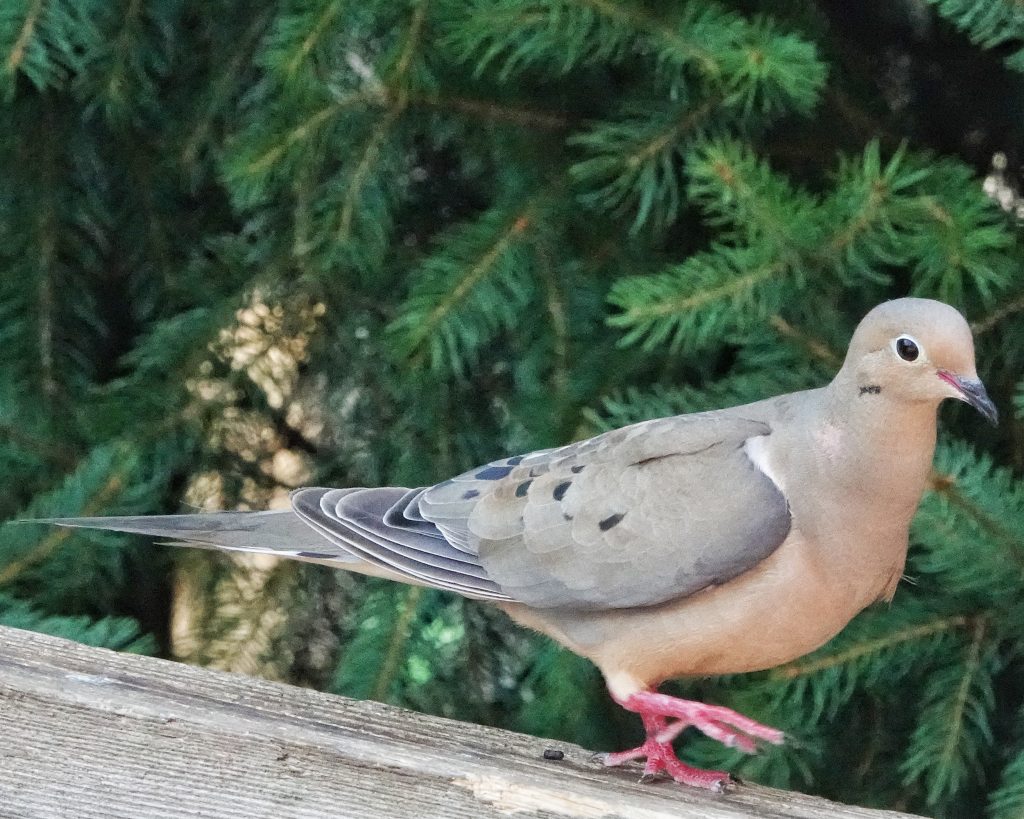
“The Mourning Dove’s swift flight makes it a popular gamebird, and habitat is often created specifically for dove-hunting. Although dove harvests are generally kept at sustainable levels, spent lead shot poses a huge problem for these ground-feeding birds. Each year, millions of Mourning Doves accidentally ingest spent pellets and die slow, painful deaths from lead poisoning…When courting, a male Mourning Dove begins with a noisy takeoff, followed by a graceful, widely spiraling aerial display over the female. During the wide spirals, the streamlined and fixed-winged male can be mistaken for a small accipiter or falcon. After landing, the male struts before the female dove with a puffed-out breast and bobbing head. Mated Mourning Dove pairs form a strong bond that lasts the entire breeding season, and sometimes for life. After pairing up, the male dove leads the female to potential nest sites in open habitats with scattered vegetation. She chooses one site. The Mourning Dove is not picky, and will nest in shrubs, vines, a wide variety of small trees, on building ledges, or in flower pots. The female builds a flimsy stick nest with help from her mate, who gathers and contributes nest materials. Nests may be so thin that the eggs can be seen from below.” Mourning Dove – American Bird Conservancy
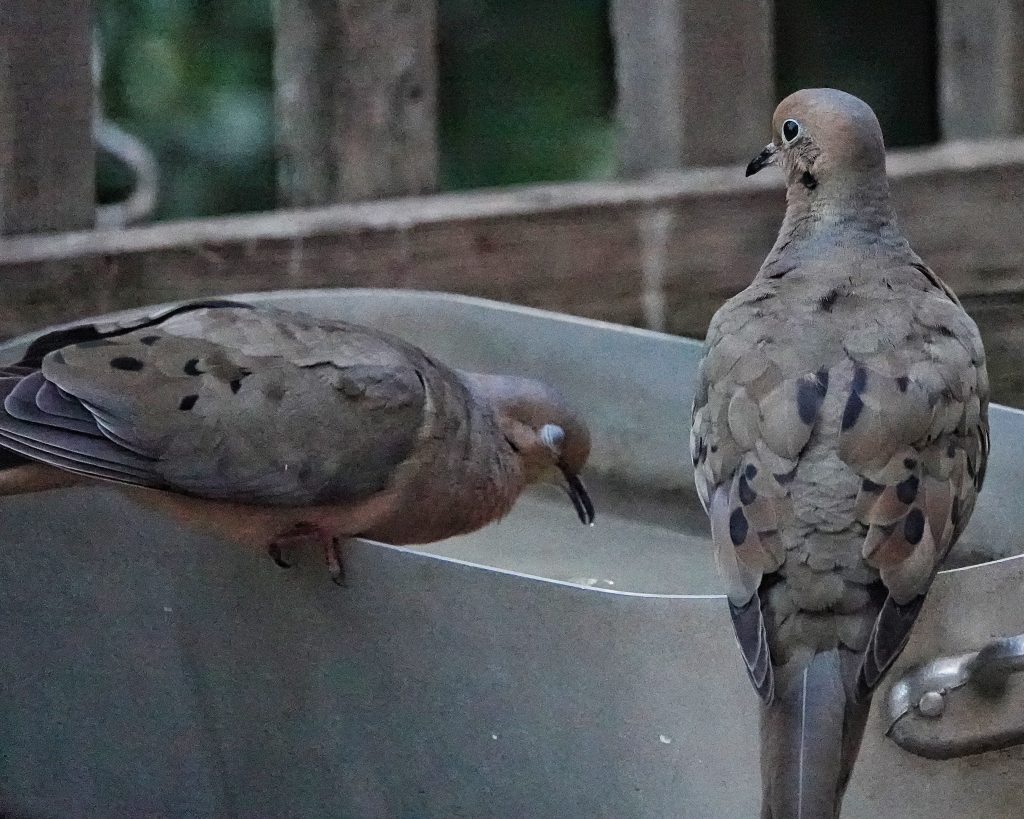
Description– “Mourning doves are medium-sized birds in the pigeon family. Their size, weight, and specific coloration vary across their range. They have a stream-lined appearance, with a relatively small head and a long, pointed tail. They are overall grayish brown on their backs with black spots on their wings and behind their eyes. There are white tips on the tail. They have a small, black bill and red legs and feet. Males are larger than females and are slightly brighter in color, males have a bluish crown and a rosy breast.” ADW: Zenaida macroura: INFORMATION
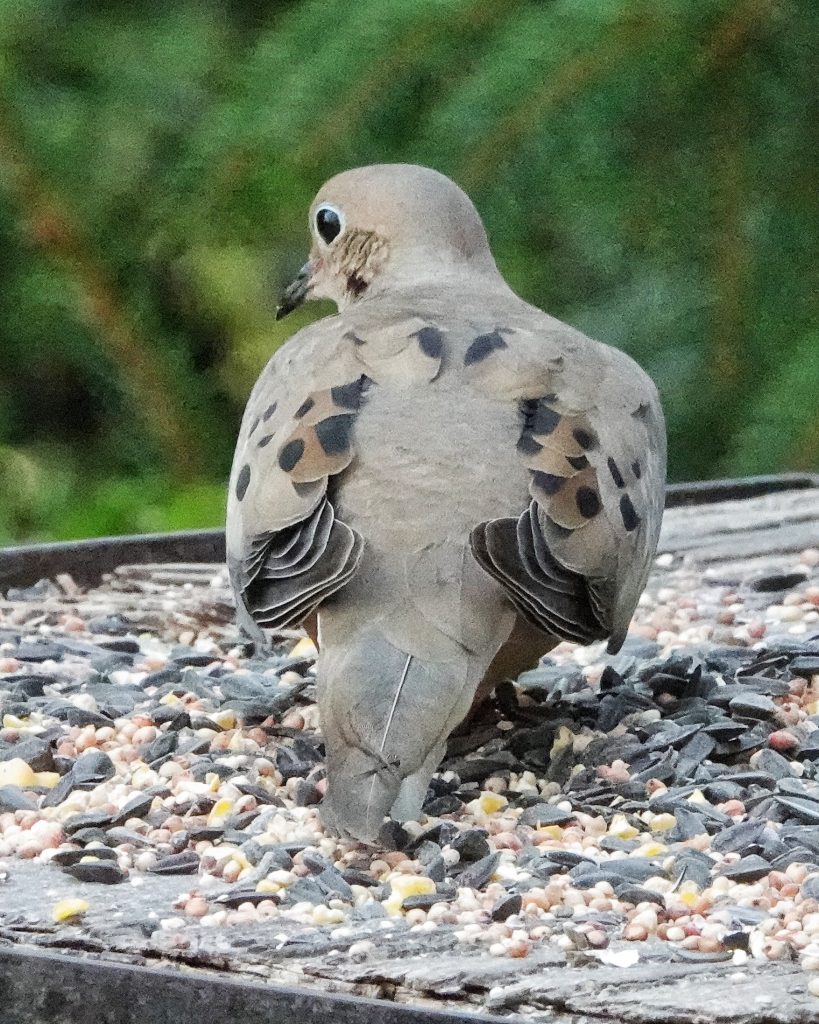
Similar species– Eurasian Collared Doves lack spots on wings, have black line bordered by white on back of neck; Band-tailed Pigeons are bluish grey rather than brown, have a yellow and black bill, and have a white line on the back of their neck; Rock Pigeons are usually various shades of grey and black, and have shorter tails.
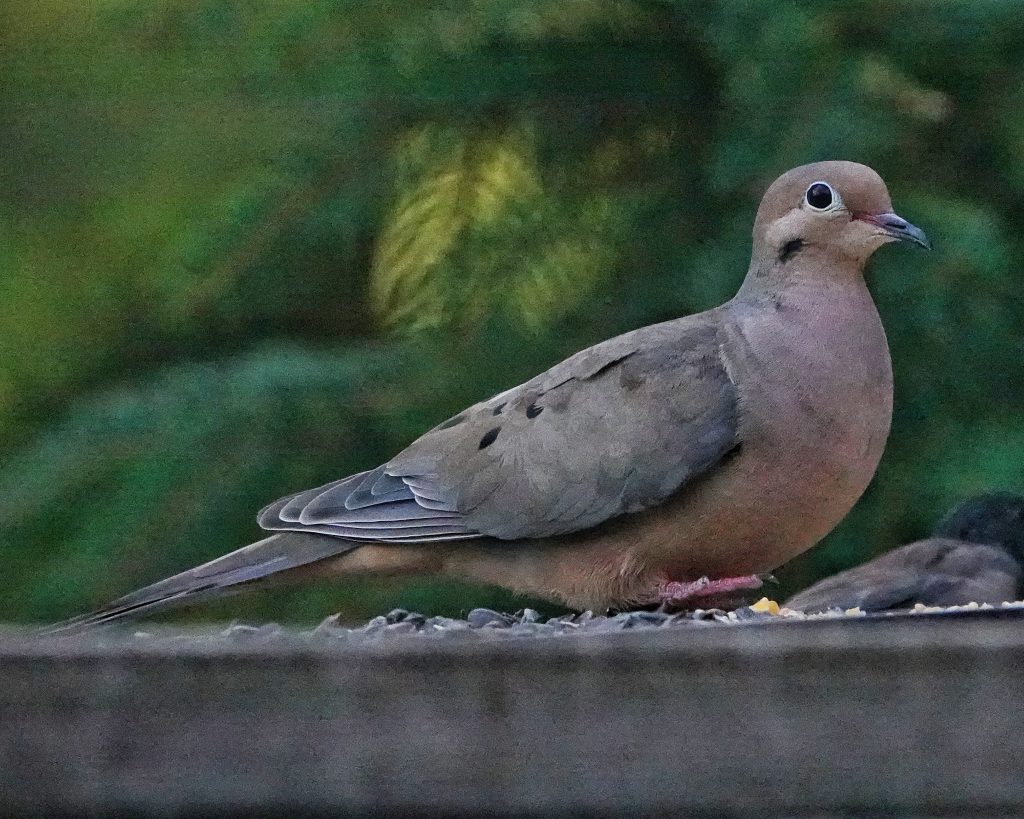
Habitat– “Farms, towns, open woods, roadsides, grasslands. Found in almost any kind of open or semi-open habitat in temperate parts of North America, including forest clearings, farmland, suburbs, prairies, deserts. May be most common in edge habitats having both trees and open ground, but also found in some treeless areas. Avoids unbroken forest.” Mourning Dove | Audubon Field Guide
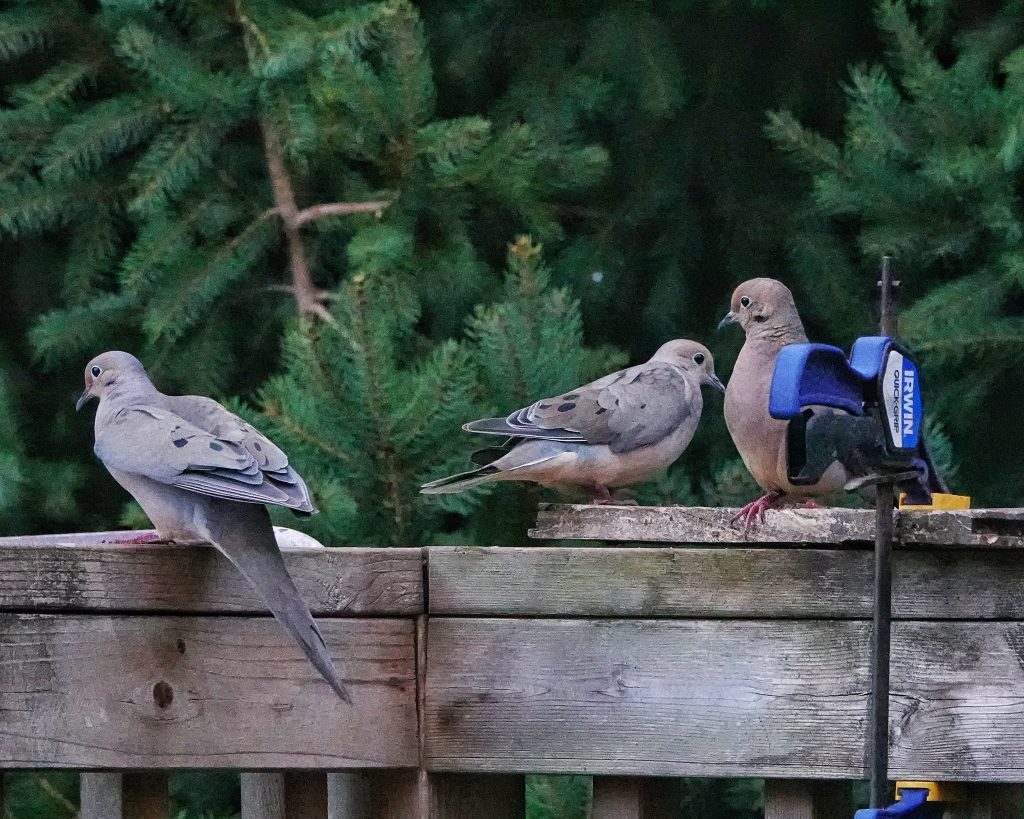
Range– Temperate North America; region wide in the PNW, although only present for breeding in the northern Cascades and Rockies.
Eaten by– Vulnerable to several species of mites, parasitic lice, louse flies, nematodes, flukes, and tapeworms. Predators are basically any carnivorous vertebrate that can catch and subdue them, including Cooper’s hawks, peregrine and prairie falcons, foxes, coyotes, bobcats, domestic dogs and (especially) cats.
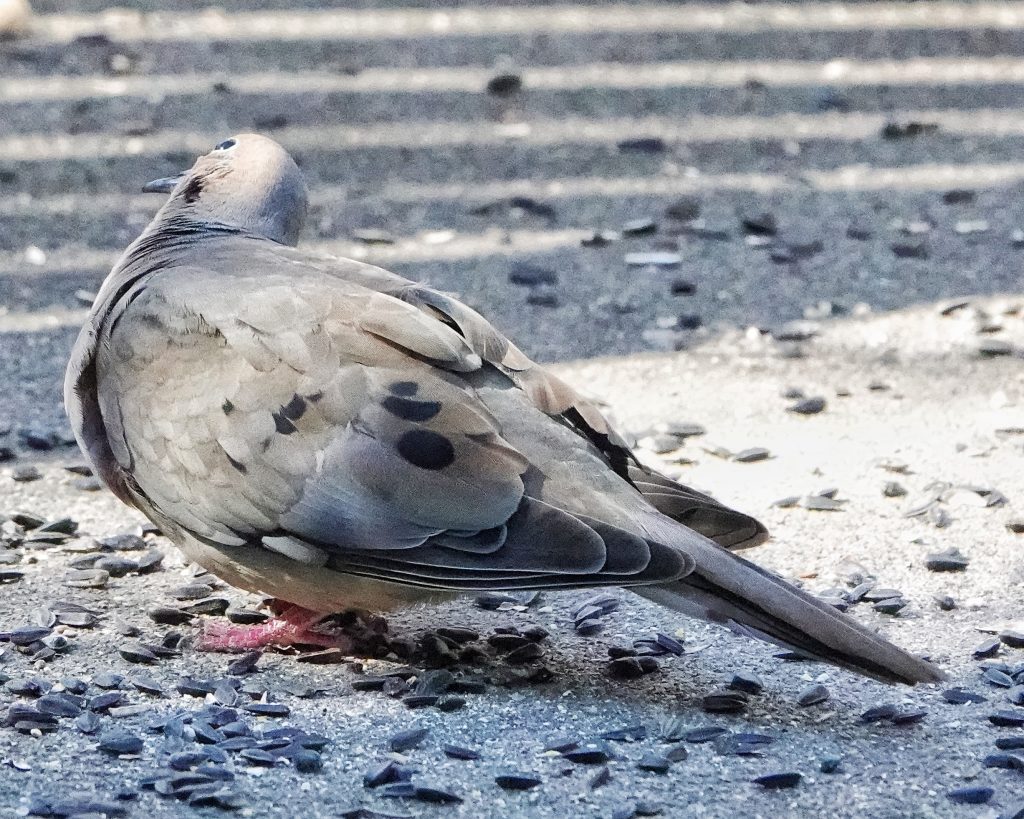
Eats– “The newly hatched young, known as squabs, are fed a special diet of crop milk regurgitated by their parents. This fat and protein-rich secretion of the crop lining sustains squabs during their first week of life, after which the parents switch to feeding them softened seeds. All pigeons and doves, as well as flamingos and the Emperor Penguin, produce crop milk for their young. Research suggests that a pair of breeding doves cannot produce enough crop milk to feed more than two young, which explains why clutches are limited to that number.” Mourning Dove – American Bird Conservancy; “Seeds. Feeds almost entirely on seeds (99% of diet). Favors seeds of cultivated grains, also those of grasses, ragweeds, many other plants. Occasionally eats snails, very rarely any insects…Forages mostly on ground; sometimes will perch on plants to take seeds. Will come to bird feeders, often eating on the ground under elevated feeders. Eats quickly to fill crop with seeds, then digests them while resting. Regularly swallows grit (small gravel) to aid in digestion of hard seeds.” Mourning Dove | Audubon Field Guide
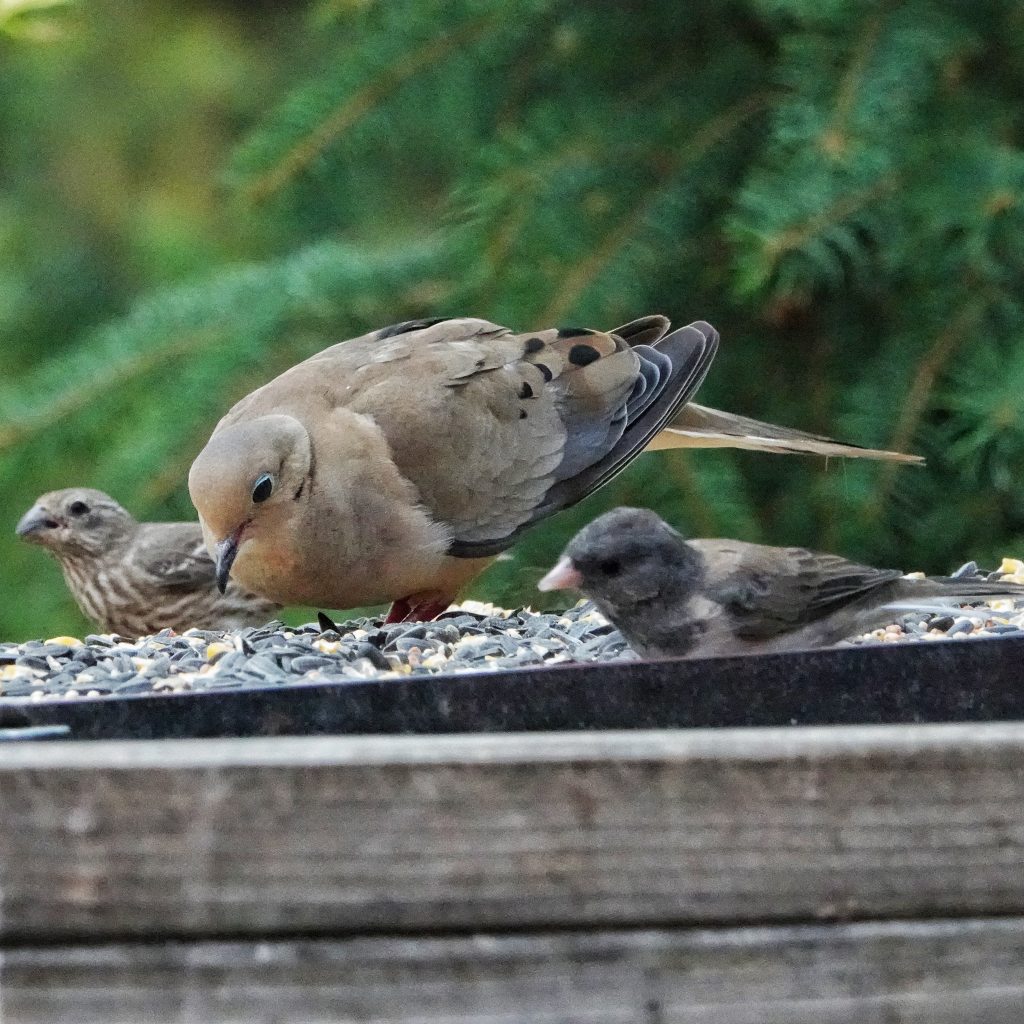
Life cycle– “Nests primarily at woodland or grassland edge, usually in trees but readily on ground in absence of suitable trees or shrubs. Eggs are short, subelliptical to elliptical. White in color with no markings. Clutch size is normally 2 but reports of 3 to 4 not uncommon (Mirarchi and Baskett 1994).” Mourning Dove – Montana Field Guide; “Both male and female mourning doves share in incubating and feeding their young. Incubation lasts 14 to 15 days. Young mourning doves are fed regurgitated food by both parents. For the first 3 to 4 days after hatching the young are fed only crop milk, an energy rich substance that is produced in the crops of both male and female parents. After that time, parents begin to add more seeds to the regurgitated food until they are fed only regurgitated seeds by the time the young leave the nest. Female mourning doves feed the young most during the first 15 days after hatching but after that males take over the responsibility for feeding the young. The young continue to stay near the nest and beg for food after they have fledged, but can survive on their own after 21 days old if there is food nearby…The young leave the nest about 15 days after hatching but remain nearby until they are more accomplished at flying, usually at about 30 days old. Young are able to breed by 85 days old. Mourning doves have the longest breeding season of all North American birds. (Basket, et al., 1993; Mirarchi and Baskett, 1994; U.S. Department of Agriculture, 2007) ADW: Zenaida macroura: INFORMATION
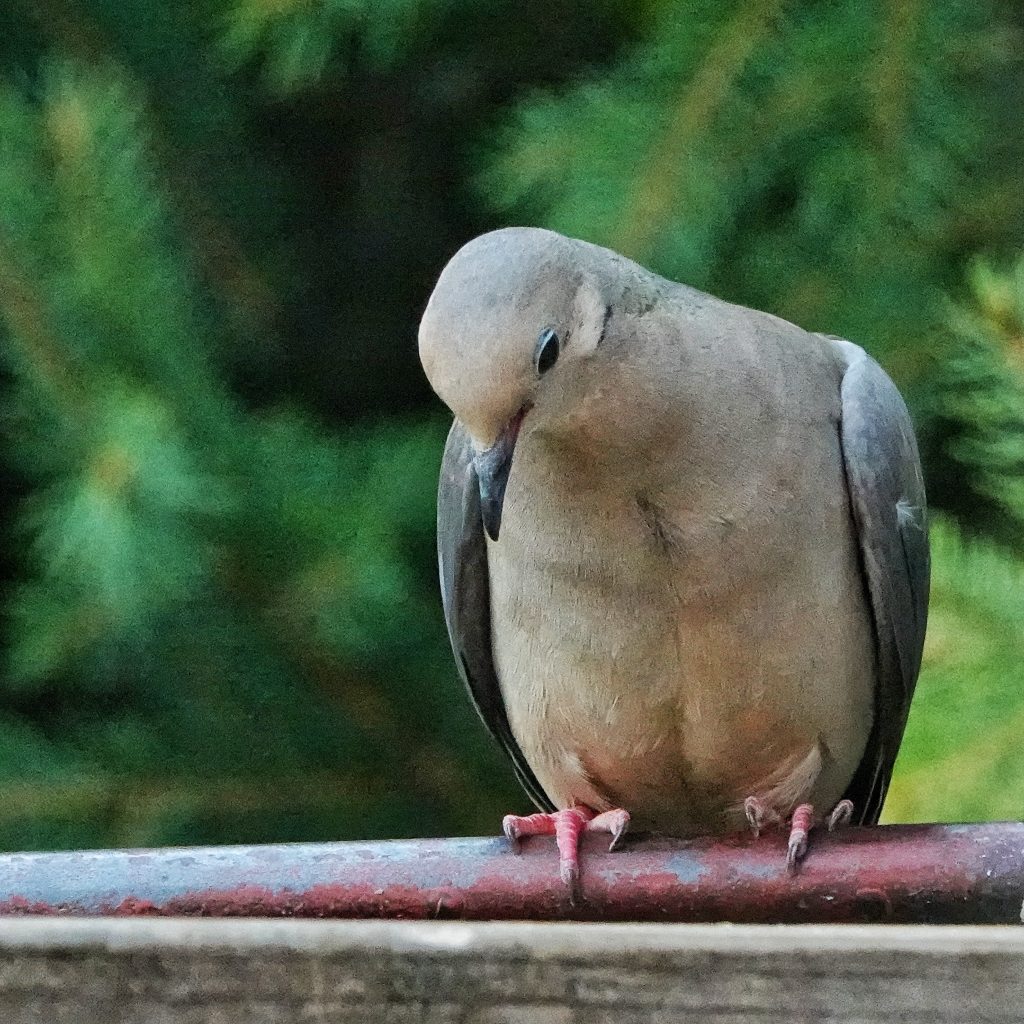
Adults active– Year around in most of our region.
Etymology of names– Zenaida were named after the wife of their original describer, CL Bonaparte, the nephew of Napoleon; it means ‘related to Zeus’ in Greek. The specific epithet macroura is from the Greek for ‘long tailed’, quite an appropriate epithet for this species.
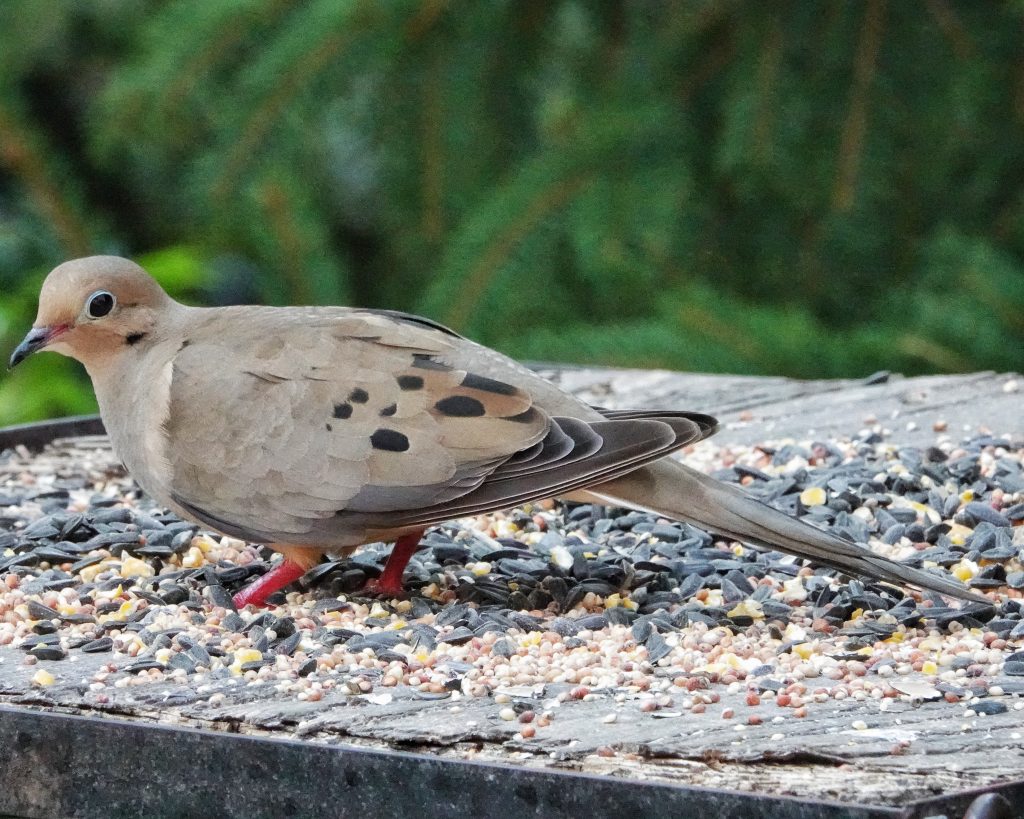
Mourning Dove | Audubon Field Guide
Mourning Dove Overview, All About Birds, Cornell Lab of Ornithology
https://www.allaboutbirds.org/guide/Mourning_Dove/species-compare/
13 Fascinating Mourning Dove Facts | Birds & Blooms
https://a-z-animals.com/animals/mourning-dove/
10 Incredible Mourning Dove Facts – AZ Animals
Mourning Dove – American Bird Conservancy
Bird of the Month: Mourning Dove | Mississippi State University Extension Service
Mourning Dove – Montana Field Guide
ADW: Zenaida macroura: INFORMATION
https://wildlife.onlinelibrary.wiley.com/doi/am-pdf/10.1002/jwmg.21835
